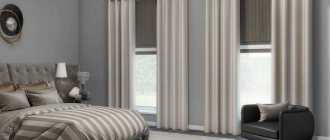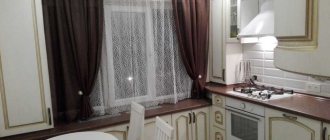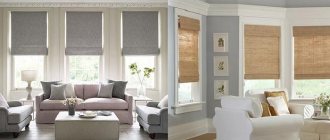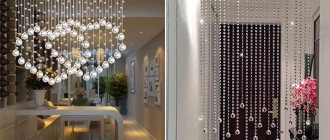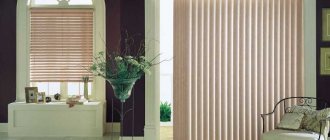How to hang curtains on a ceiling cornice using hooks
The upper part of the hook is attached to the grooves of the cornice, the lower part is attached to the eyelets on the curtains. How to hang a curtain correctly:
- Make loops on the top of the fabric at a distance of approximately 10 cm from each other.
- Insert the narrow bottom part of the hooks into the eyelets.
- Remove the stopper on the curtain rod, insert the upper parts of the hooks into the grooves.
- Distribute the fasteners along the “track”, install the clamp between the first and second elements.
Fastening with hooks to the cornice
Types of curtain fastenings
When the base has already been selected, you should choose curtain mounts, which are also varied in functionality and design.
- Rings. Can be of different sizes, colors and materials. They are attached to the fabric with hooks that are tied with ribbons or sewn on. Used on a curtain rod. They glide easily, making moving the curtains easy.
- Hooks. They are threaded into the guides of the cornice, and the curtain is attached to the lower part. There are hooks for rings.
- Clamps. They fit into the guides, but can also come complete with rings. They come in different sizes and shapes and are very convenient to use.
- Eyelets. The rings that are located on the curtains themselves - in the upper part where the curtain rod is threaded, the diameter of the rings should match the diameter of the rod.
- Loops. They are used only for curtain rods, as they are tied to the base. They are sewn onto the curtain, usually chosen to match the color of the curtains or the same fabric.
How to hang curtains if there is no room for a curtain rod
Use a barbell and hooks. Place fasteners on each side of the window opening and place the crossbar on them. You can hang the canvas in any convenient way: on hooks, decorative ribbons, loops.
Curtain rod
The second option is a telescopic cornice in the form of a tube with dense tips. It does not need to be mounted - the product is attached using the spacer principle.
Advice! If you have light, fluffy curtains, you can install ceiling holders and stretch a string between them. Curtains with eyelets are ideal for string cornices.
Varieties
Cornices are designed to support curtains, also embodying decorative functions in the interior of any style. But before choosing the right cornice, you need to carefully measure everything, take into account the location and shape of the window, the weight and type of curtains, and the style of the interior. The following types of cornices are distinguished.
By mounting methods
- Ceiling. It is attached to the ceiling with screws, consists of a profile and guides, most often made of aluminum or plastic. A huge plus is that it can be attached regardless of how much space there is from the ceiling to the window.
- Wall. A classic look that attaches to the wall using special brackets. To make such cornices, plastic, metal or natural wood are used. The advantage is the many varieties of design.
By appearance
- Barbell. A traditional wall cornice in the form of a rod with several guides on which you can simultaneously place curtains, tulle and lambrequins. The fabric is hung mainly on ring fastenings, which easily move along the bar without impeding their movement. The rod, ends and main holders can be chosen in different colors, shapes and designs, for example, in the Art Nouveau style.
- Baguette. A flat cornice that can be attached to both the wall and the ceiling. The hidden plastic rail makes the fastenings and the top of the curtain invisible, and the folds are even. The edges of the base can be chosen to be rounded and placed across the entire wall; this solution makes the frame seem to be one with the wall, and looks neat and stylish. Most often it is made of plastic, which makes it light and inexpensive, and is selected in accordance with the desired color, texture or pattern.
- Cornice-string. It has a stretched metal cable between holders that are attached to the wall or ceiling. Used to place light fabrics - tulle, organza, nylon. You should not hang heavy curtains on such a curtain rod, as over time the string may sag. Often used in the kitchen.
According to the guide system
- Flexible. A narrow cornice, which is used for both standard windows and non-standard shapes - arch, attic, bay and triangular windows, their base is polymer-metal.
- Telescopic. It is spacer with a sliding bar. It is installed when it is not possible to attach it to the ceiling or walls. When attaching it, no drilling of walls is required, since there is a spacer mechanism with a spring inside the base. Often such cornices can be seen in bathtubs.
- Profile. It is universal as it can have different lengths and widths. At the base there are guides for runners; they can be mounted on both the wall and the ceiling. They will fit well into a loft or Scandinavian style, since if you match them to the color of the walls, they will be almost invisible. Currently very fashionable.
By material
- Metal. Aluminum is mainly used.
- Wood. Made from birch, pine, walnut or beech.
- Plastic.
Also, all rails or rods are single-tier, two-tier or three-tier, depending on how many layers of curtains are used.
Where are curtains attached to a suspended ceiling?
It is better to provide a cornice at the stage of installation of the ceiling surface. Options:
- Open method. A block is fixed under the ceiling sheet, to which the structure will then be attached.
- Hidden way. In this case, there remains a niche between the suspended and main ceilings. This is the space for installing the cornice.
Open cornice
Hidden cornice
Advice! If you forgot to provide provisions for the cornice, use a rod with wall brackets. This system will avoid stress on the ceiling canvas.
How to choose the right method for attaching curtains?
Before deciding whether to hang curtains and where to hang the curtains, you need to consider the following factors:
- Number of textile layers
. The curtains include: main and auxiliary curtains, tulle and lambrequin. All this affects not only the type of fastening, but also the appearance of the cornice. - General style of interior design.
Romantic ruffles are unlikely to be appropriate in practical styles such as minimalism, and strict curtains in overly noble colors are also not the best option if all other interior items are airy and light. - Type of curtains
. For example, roller blinds require a non-standard approach, while regular blinds are a practical solution for any interior.
Decorating the top edge of the curtain
The method of preparing the top edge of the curtain depends entirely on the type of fastenings, the type of cornice, the design of the room and the quality of the chosen fabric.
- Kuliska. The top of the curtain is folded and stitched, leaving room for stringing onto a cornice (pipe, rod, string, rod). For greater decorativeness, the top of the drawstring can be decorated with lace, ruffles, and gathered in spectacular folds. Typically, a drawstring is used if the curtains are not planned to be moved frequently along the cornice.
- Curtain braid. A simple and practical way to immediately prepare loops for hooks and decorate the top edge. Cords are laid along the entire length of the braid, with the help of which folds of the desired thickness and splendor are formed. Curtain braid saved housewives from having to sew on eyelets for hooks by hand. The upper edge of the canvas can be decorated using single-row or double-row braid. If you hang it by the loops located in the second row, the drapery will cover the places where it is attached to the cornice - this is very convenient if there is no baguette or decorative strip.
It is not advisable to use curtain tape on dense and too heavy fabrics - the folds will become brittle.
- Ties. This is a type of loop fastening where the loose ends are simply tied to a rod or pipe in the form of knots or bows. Curtains with ties are convenient to hang and remove, and if the length allows, you can adjust the height of the curtains if necessary. Fastenings with ties look especially romantic, so they are appropriate in a girl’s nursery, bedroom, kitchen or room decorated in country style.
- Velcro. It is used when the curtain is not supposed to be moved along the cornice: lambrequins, Roman blinds, Japanese panels. Sometimes curtain rods are sold with ready-made Velcro on a plastic tire. If there is none, it is easy to attach Velcro to the cornice yourself using a construction stapler or glue.
Related article: Israeli-made Pandoor doors: features and models
The design of a window opening requires preliminary preparation in choosing a cornice, fabric, and all decorative elements so that they harmoniously combine with each other and with the overall style of the furniture and room.
Main types of curtain rods: what are curtains hung on?
Consider what types of curtain rods and mounts are available on today's product market that are right for you, so that you can choose the right option and understand what you can use to hang your tulle or curtain.
- Ceiling
- these cornices are especially relevant for small rooms. On the ceiling cornices you can place any type of curtains, from light and heavy fabrics. Ceiling cornices are classified by type of construction into: string, rack, rod. - Profile
- these curtain rods are made of aluminum profile, most often white. The curtains are attached to the curtain rod runners using plastic hooks. - Circular
- these cornices consist of one, two or three pipes. Such cornices are made of wood or metal of various diameters. For round curtain rods, the following options for attaching curtains are possible: with plastic hooks and rings, with rings made of plastic or metal, using various fabric loops, using eyelets, using clips. - Baguette
- these cornices fit harmoniously into the most modern interior. A characteristic feature is a decorative strip that hides the structure itself. Curtains on such a curtain rod can be placed using any type of fastener.
Traditional curtain rods
The modern range of curtain rods is so large that it allows the buyer to choose the right type for any room interior. Cornices differ in shape, design, method of attachment to the plane and the materials from which they are made.
- Cornice rod is a classic type of cornice that can be made of wood, metal, plastic and metal-plastic. The rod is attached with brackets to the wall or ceiling; it can have several rows for hanging different types of curtains at the same time: curtains, tulle, lambrequin. If the windows are too wide, then experts recommend installing another bracket in the middle of the rod so that it does not sag. On both sides, at the ends of the rod, fleurons are installed, which can be selected taking into account the design of the entire window. In most cases, the kit includes rings for attaching curtains, which slide perfectly along the rod. Metal-plastic curtain rods are available in a wide range of primary colors and natural wood (walnut, oak, cherry, mahogany), which is most in demand in living rooms.
- String cornice - the long-known design of ceiling and wall cornices can be either single-row or multi-row. String curtain rods are used for curtains made of light fabrics: nylon, nylon, tulle, organza. Under heavy fabrics, the string begins to sag over time. Ideal for rooms with suspended ceilings, kitchens or children's rooms.
- Baguette cornices look beautiful, stylish and hide the place where curtains are attached. A wooden plank or plastic strip can be used as a baguette, which is decorated to match the fabric or the decoration of the room in a classic style. Wooden baguette cornices are the most reliable and can withstand heavy curtains and multi-tiered curtains. You only need to buy a baguette cornice after decorating the interior of the room, since its decor must be combined with the overall design of the room.
Related article: Warm electric baseboard: infrared option
A separate group includes curtain rods for children's rooms - light and bright systems with reliable brackets made from environmentally friendly and safe materials. With children's curtain rods, you can buy curly tips, bright clips or “fun” magnets for fastening.

